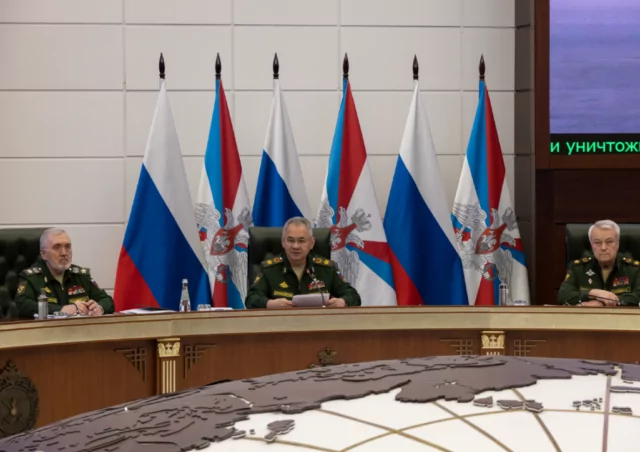Pavel Luzin

Executive Summary:
- Russian Defense Minister Sergei Shoigu announced the creations of a new army corps, motor rifle division, and Dnipro River flotilla, along with the establishment of 30 large unspecified units.
- Moscow’s manpower resources and the size of the officer corps remain limited, and these new divisions and brigades are doomed to be understaffed without a significant expansion of the officer corps and massive conscription.
- The Russian High Command may create an organizational framework to increase the number of drafted soldiers and/or another round of mobilization despite demographic and economic limitations.
On March 20, Russian Minister of Defense Sergei Shoigu announced the establishment of a new army corps, motor rifle division, and Dnipro River flotilla. He also claimed that two combined armies, 14 divisions, and 16 brigades would be established in 2024. Shoigu did not, however, clarify the specific make-up of these 30 large units (e.g., motor rifles, artillery, etc.) (Russian Ministry of Defense (MoD), March 20). These efforts followed the establishment of the Leningrad and Moscow military districts three weeks ago and build on the Ministry of Defense’s (MoD) course to increase the assigned strength of the Russian Armed Forces and the number of positions available for generals (see EDM, February 29). The MoD’s efforts will likely come with significant difficulties primarily related to heavy losses along the Ukrainian frontlines, a limited office corps, and the prospects of public uproar in the face of mass mobilization.
Russian manpower resources and the actual size of the officer corps remain limited. Consequently, Moscow can employ three main means to establish the planned units: (1) transforming the existing brigades into new divisions, which has taken place over the past decade; (2) redistributing units and arms from existing units and military districts; and (3) transforming the existing separate motor-rifle regiments staffed by mobilized soldiers, prisoners, recently recruited contracted soldiers, and soldiers deployed in Ukraine into the new brigades and divisions. These new groupings, however, are doomed to be understaffed without a significant expansion of the officer corps and massive conscription.
The reported manpower increase in the Russian Armed Forces from 1,150,628 troops to 1,320,000 troops corresponds with the total assigned number of 14 divisions and 16 brigades, which consist of 170,000 soldiers and officers (Kremlin.ru, December 1, 2023). The MoD is creating new units according to the assigned military budget; however, the devil is in the details. The Kremlin’s elevated military spending will likely hurt the domestic economy as a whole and may be difficult to put into practice due to lost revenue from Western sanctions.
The course toward establishing new units has been in motion since Russia’s first campaign against Ukraine in 2014 and 2015, also the beginning of open confrontation with the West. In 2016, three motor rifle brigades were transformed into the 144th and 3rd motor rifle divisions of the Western Military District and the 150th Motor Rifle Division of the Southern Military District. The last division became the core for the 8th Combined Army established in 2017. Besides the 150th division, this unit essentially incorporated the troops unofficially deployed in the so-called “people’s republics” of Donetsk and Luhansk. Simultaneously, the 42nd Motor Rifle Division was re-established as part of the 58th Combined Army of the Southern Military District. In 2020 and 2021, at least two motor rifle brigades of the Southern and Eastern military districts, respectively, and one tank brigade of the Western Military District were transformed into divisions (Interfax, May 4, 2016; Interfax-AVN, June 3, 2016; Vedomosti, March 22, 2020; Moyaokruga.ru, December 10, 2021).
The 150th Motor Rifle Division example testifies to the reality that transformation takes time and that the new divisions could be significantly understaffed. The original schedule for the division’s establishment was sometime in 2017, but it was only completed three years later in March 2020. Moreover, only 1,500 drafted soldiers were in the division in 2016 and 2017. Even if the number of drafted soldiers in the 150th Motor Rifle Division only comprised half of the division, the total number of troops in the division was far from the usually assigned scale of 6,000 to 9,000 soldiers and was closer to the numbers of an understaffed motor rifle brigade, a designated number of which is generally 4,000 soldiers (TASS, December 2, 2016; MoD, January 19, 2017; MoD, March 20, 2020).
Simultaneously, voices within the Russian military called for more concerted efforts in establishing additional divisions and combined armies. The relatively slow process was further stalled by long-term bargaining within Russia’s political and military leadership. These efforts, however, have remained an urgent priority for the MoD and the Kremlin since 2022 (TASS, February 2, 2016; Gazeta.ru, July 27, 2016; Kremlin.ru, December 21, 2022).
The primary source for the new divisions and brigades would likely be found among the separate regiments established since the “partial” mobilization in September and October 2022 and the massive recruitment of prisoners (see EDM, October 31, 2023, November 8, 2023). Depending on the MoD’s decision, these units may be combined into divisions or transformed into brigades. Even so, the Russian leadership could create an organizational framework to increase the number of drafted soldiers and/or another round of mobilization despite demographic and economic limitations. This may prove to be difficult as the next wave of mobilization will likely target city centers, running the risk of exacerbating growing fatigue among the Russian population regarding the “long war.”
No comments:
Post a Comment